Learn from Failing Workforce Initiatives to Build Manufacturing Talent
It’s time the frontline workforce is seen as one of the most critical industrial assets. Discover key insights on future-proofing your frontline...
The digital frontline has become more of a reality and less of a pipedream across the industry. Today, over 25% of manufacturers have adopted Connected Frontline Workforce (CFW) initiatives. It’s becoming more common nowadays to see Industrial Transformation (IX) programs integrating CFW solutions as an essential element to improve the employee lifecycle.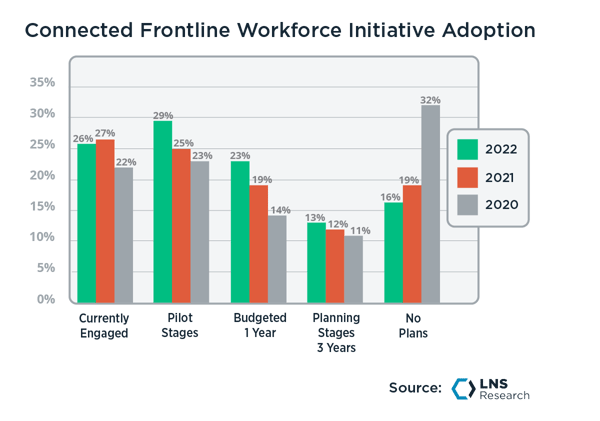
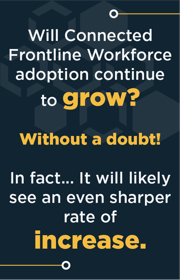 The CFW solution space is a fragmented market with several vendor offerings. LNS Research has been the leader in defining the space and accelerating adoption. Over 50% of manufacturers have deployed CFW solutions, with over 20% having budgeted for implementation in the next year.
The CFW solution space is a fragmented market with several vendor offerings. LNS Research has been the leader in defining the space and accelerating adoption. Over 50% of manufacturers have deployed CFW solutions, with over 20% having budgeted for implementation in the next year.
Will the current adoption trends continue? In short, yes. The positive impact is clear, and adoption rates will steadily increase as manufacturers look to capture the value these solutions provide. CFW investments have also enabled other emerging technology, such as AI, to find traction within manufacturing.
My focus for today is to explore how the AI craze may impact the CFW wave of success that industrials are riding.
Connected Workforce research first began in 2018 as LNS Research defined enhanced mobile capabilities with advanced digital technologies. In 2020, Connected Frontline Workforce initiative research identified 60% of manufacturers hadn’t yet quantified bottom-line value from CFW pilots. Today, that number has shrunk to 34% as industrials continue to find use cases and business case justification continues to grow.
I recently heard someone say, “My workforce isn’t ready for digital technology.” That’s a very flawed view. Workers of all ages are using digital resources more commonly, both personally and professionally. The more mature workforce is even becoming increasingly dependent on digital technology. When’s the last time you kept an instruction manual as opposed to circular-filing the paper and relying on the internet if needed?
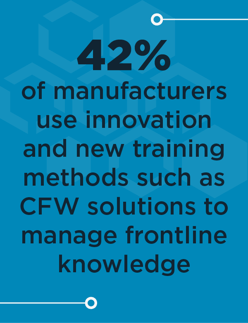 Only 34% of manufacturers stated frontline worker resistance as a challenge to CFW initiatives. Shifting workforce demographics are forcing manufacturers to look at next-gen worker expectations. Digital natives entering the workforce have only known a digital world, and technology is a basic expectation. Retirees are even fully embracing the technology to solve the problems they’ve complained about for years.
Only 34% of manufacturers stated frontline worker resistance as a challenge to CFW initiatives. Shifting workforce demographics are forcing manufacturers to look at next-gen worker expectations. Digital natives entering the workforce have only known a digital world, and technology is a basic expectation. Retirees are even fully embracing the technology to solve the problems they’ve complained about for years.
Research shows one out of every five CFW initiatives delivers meaningful corporate value; 38% of all manufacturers and an incredible 80% of IX Leaders have made progress and realized corporate value. Human-centric technology is doing more than improving organizational performance. A significant benefit is being able to engage employees more directly in top IX sub-initiatives such as Environmental Social Governance (ESG) and Customer Experience programs.
By enabling real-time, bi-directional data, the workforce of today and tomorrow is better equipped to identify issues and take action to meet stakeholder expectations. That said, CFW solutions alone aren't sufficient to fully achieve a future-ready frontline workforce. It is a component of a proactive and comprehensive approach to redefining industrial work, which we define as the Future of Industrial Work (FoIW).
Emerging technologies are making waves across the industry – with proponents and skeptics weighing in on the latest Artificial Intelligence (AI) developments in the news. LNS Research has reported on Industrial AI applications for 10+ years and continues to identify the applications that deliver step change results. Recent FoIW research found that Leaders, the 20% of companies with real success and delivering value that we label as Industrial Transformation Leaders (IX Leaders), are two times more likely to use AI-enabled advanced analytics capabilities.
Fifty percent of manufacturers currently support frontline operations with AI, with the most common use cases reported as:
Training and skills development
Real-time work performance support
Providing dynamic and personalized content
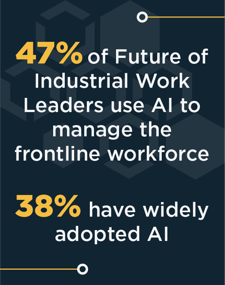 AI has been described as using machines and/or systems, such as computers running algorithms, to learn behaviors and solve problems. For years industrials have deployed the technology to identify trends, make comparisons, and get early indicators for potential abnormal events. More recently, manufacturers have been able to unlock significant improvement by moving beyond predictive analytics to prescriptive and prognostic insight with the help of AI.
AI has been described as using machines and/or systems, such as computers running algorithms, to learn behaviors and solve problems. For years industrials have deployed the technology to identify trends, make comparisons, and get early indicators for potential abnormal events. More recently, manufacturers have been able to unlock significant improvement by moving beyond predictive analytics to prescriptive and prognostic insight with the help of AI.
These solutions can identify when an activity may not be on task and offer a refresher video to improve quality and productivity just in time at the employee’s workstation. Vision systems, for example, can flag errors before the human eye recognizes or misses an issue. AI usage will continue to grow as industrial use cases become clearer, with 16% of manufacturers reportedly working toward deploying AI to solve challenges and improve outcomes.
Research indicates that it is more than possible for actual learning systems, if used properly, to be created using existing knowledge. A common pitfall is failing to use failure modes and effects analysis (FMEA) models as a starting point for AI algorithms and cultural connection with existing engineers in the industry. There is still much work left to be done for all advanced industrial analytics/IIoT platform players to crack the code to AI for industrial assets.
Emerging technologies have been making significant headway across the industry, with a recent AI craze going viral and sparking deep conversations across the globe.
Recent FoIW research found over 15% are already using CFW AI-enabled solutions. The upcoming LNS Research CFW Solution Selection Matrix will dive deep into vendors in the market and provide end-users with a full analysis of each CFW product offering, including AI capabilities. 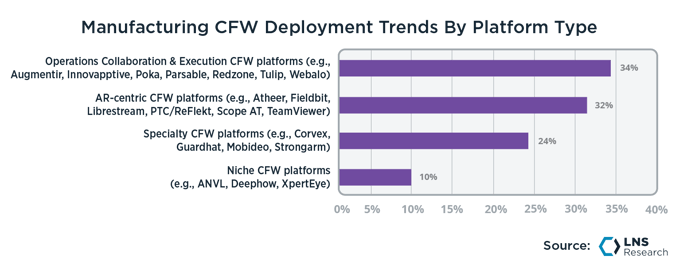
Four defined CFW platform categories have been developed to assist solution seekers.
Operations Collaboration & Execution solutions provide digital work
instructions, integrate data from multiple systems, and enable cross-operation collaboration.
AR-centric provides digital work instructions while supplying context-relevant digital content and real-time remote collaboration to the frontline.
Specialty provides tailored hardware and specialist capabilities that can include pre-configured use case support, advanced analytics, and remote assistance on top of digital work instructions, system integration, and collaboration solutions.
Niche provides focused capabilities and use case support. Examples may include remote assistance, training, and domain-specific solutions.
%20Leader%20Connected%20Frontline%20Workforce%20(CFW)%20Platform%20Trends.png?width=200&height=401&name=Industrial%20Transformation%20(IX)%20Leader%20Connected%20Frontline%20Workforce%20(CFW)%20Platform%20Trends.png) Multiple vendors across the defined categories have incorporated AI within their CFW offerings to include Librestream, Honeywell, Corvex, and Augmentir. Right on the heels of a spike in AI discussions, Augmentir, an AI-embedded CFW platform, announced: “it is expanding its AI platform to incorporate the foundational technologies underpinning ChatGPT.”
Multiple vendors across the defined categories have incorporated AI within their CFW offerings to include Librestream, Honeywell, Corvex, and Augmentir. Right on the heels of a spike in AI discussions, Augmentir, an AI-embedded CFW platform, announced: “it is expanding its AI platform to incorporate the foundational technologies underpinning ChatGPT.”
As an AI-enabled CFW platform, we can’t say the announcement is altogether that surprising. Maybe this move has been planned for quite some time. Or maybe this news was just timed to increase the platform’s visibility, given the AI chatter.
AI-enabled advanced analytics software has offered manufacturers improved operational performance by creating advanced Asset Performance Management (APM) strategies through APM 4.0 technologies. The main value proposition for some industry-specific applications has been proprietary algorithms that benefit from information sharing across value chain participants. The Asset Performance Management Solution Selection Guide evaluates 13 vendors at a macro level to assist members in quickly identifying which vendor solutions to investigate further. A critical capability of APM 4.0 solutions includes prescriptive analytics enabled by machine learning (ML) and AI.
When we defined the IX Platform, we noted IX Program initiatives would have to be adaptive to changes in the market to achieve operational step-change improvements. The Solution Selection Matrix (SSM) for IX Platforms published just over a year ago provides manufacturers with an in-depth analysis of the IX Platform market. As we suggested, market trends continue to emerge, with vendors blurring the lines of analytics and IX Platforms. Advanced analytics applications designed for manufacturers have begun including more and more AI capabilities by many vendors.
Proponents and skeptics across all walks of life have been weighing in and debating the risks and rewards of AI. Given the airtime, I can say those already looking for CFW solutions are likely to give AI-enabled platforms a harder look than they would have at the beginning of the year. Riding the wave of the AI craze may very well be the way for CFW vendors to get their solutions to a broader market.
We will continue to monitor the CFW space and advanced analytics capabilities. There has been a notable uptick in acquisition inquiries, with many general AI players already looking hard at CFW vendors – with more to look at in the future. Our prediction is Enterprise Resource Planning (ERP) vendors won’t be far behind. ERP software company QAD, backed by Thomas Bravo, has already acquired the Redzone CFW solution and analytics/workflow player Livejourney.
Manufacturers who have implemented CFW solutions are seeing business value as well as empowering the workforce to improve attracting and retaining frontline workers. To help manufacturers with solution selection, LNS Research continues to provide insight into key capabilities CFW solutions offer and how they are part of the overall strategy to develop sustainable, reliable, and future-proof operations.
Connected Frontline Workforce Initiatives should be a given: Manufacturers who aren’t pursuing or planning CFW solutions are behind the curve. CFW applications provide infinite use cases, many are being successfully scaled, and IX Leaders, as well as Followers, are achieving meaningful value.
The future-proof workforce needs technology: CFW solutions should be on the short-list of tools to invest in to navigate the shortage of labor and bridge the skills gap. Many platforms offer workforce skills management to support learning and development across the frontline. Advanced analytics capabilities enable the workforce to be more agile, reach operational improvement goals, and more.
Emerging technology, and yes, AI, delivers significant value: Use cases are in the earlier phase of market adoption, but the use cases can be limitless: improved workplace safety, better-mitigated risk, lower maintenance costs, and higher OEE, to name a few. There is tremendous untapped potential to apply emerging digital technologies within manufacturing.
Be cautious about implementing technology for technology’s sake: Don’t be lured in by shiny new objects. The increased buzz of ChatGPT is one of many emerging technologies that need to be fleshed out a bit to show applicability to industrial clients. Case studies are important to understand how the CFW functionality and capability are further enhanced by emerging technology such as AI to accelerate business value.
The CFW market will remain fragmented in the near future, but the space is evolving into a market of its own. Stay tuned for the Connected Frontline Workforce Solution Selection Matrix coming soon to support your industrial transformation program.
As a member-level partner of LNS Research, you will receive our expert and proven Advisory Services. These exclusive benefits give your team:
Let us help you with key decisions based on our solid research methodology and vast industrial experience.
BOOK A STRATEGY CALLSiemens Acquires Camstar: Better Realizing Innovation for 3 Vertical Industries
The Definitive Guide to Manufacturing Acronyms
Five Ways Industrial AI is Shaking Up Manufacturing (and Who’s Doing It)
Top 6 Challenges in Electronics Manufacturing
What Is Industrial DataOps & Why Does Every Manufacturer Need It?
It’s time the frontline workforce is seen as one of the most critical industrial assets. Discover key insights on future-proofing your frontline...
Connected Frontline Workforce (CFW) technology is a proven enabler in today’s operations environment. Learn how to accelerate your CFW Value Curve...
Empowering a connected frontline workforce with real-time insights is key to overcoming challenges and driving improvements in safety, quality, and...
The Industrial Transformation and Operational Excellence Blog is an informal environment for our analysts to share thoughts and insights on a range of technology and business topics.